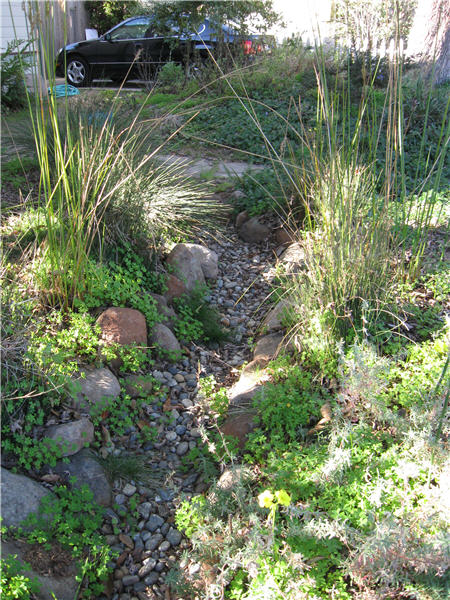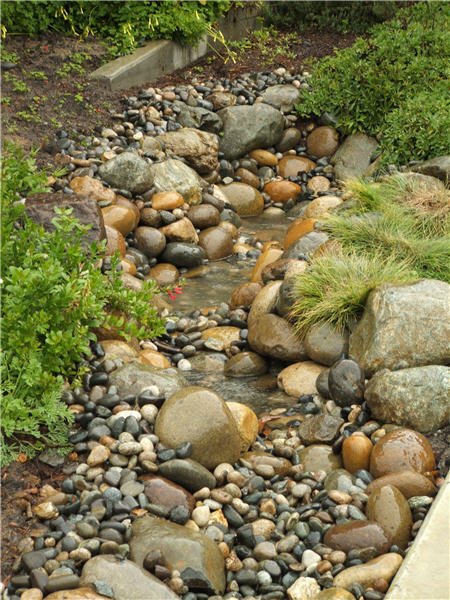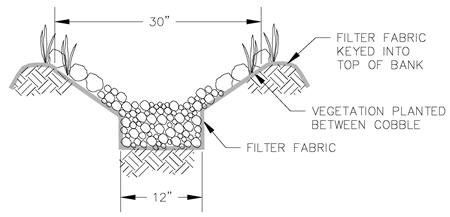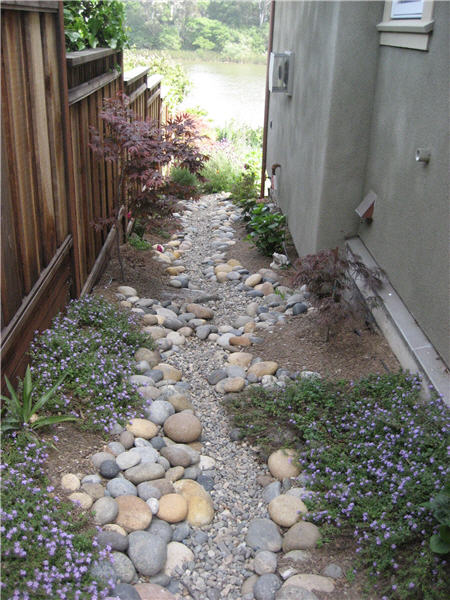- TABLE OF CONTENTS
- REDUCE YOUR WATER NEEDS
- Use Drought Tolerant Plants
- California Native Plants
- Climate Zones
- Reduce or Replace Lawn
- Artificial Turf
- IRRIGATE EFFICIENTLY
- Water Needs of Plants
- Before You Design
- Types of Irrigation Systems
- Weather Based Irrigation Controllers
- Working with an Irrigation Contractor
- DEVELOP ALTERNATE SOURCES OF WATER
- RETAIN WATER IN THE LANDSCAPE
- Build Retaining Walls
- Mulch to Reduce Evaporation
- Install Permeable Hardscapes
- Amend Soil with Organic Materials
- KEEP YOUR WATER PURE
- Drainage
- Eliminate Runoff and Overspray
- Slow it, Spread it, Sink it
- Ocean Friendly Gardens
- Rain Gardens
- Swales
- Keep Your Watershed Beautiful
- Soil
- Pests
- Select Plants that Don't Need Chemicals
- ADDITIONAL GARDENING RESOURCES
Swales
Create Swales (from Slow it, Spread it, Sink it! A Homeowner’s Guide to Greening Stormwater Runoff, Resource Conservation District of Santa Cruz County)
Uses: Roof, walkway, driveway, or parking area runoff; low to moderately sloped hillsides
Swales are shallow channels designed to SLOW water down, SPREAD it out and allow it to SINK into the soil during low flows. Once saturated, they convey water to a safe outlet such as a rain garden (page 27) or other infiltration areas. They can be formed to fit almost all site conditions and landowner objectives. Depending on the existing landscape and available space, swales can have a meandering or nearly straight alignment. An advantage to a meandering swale is that its geometry maximizes the time water spends in the swale thus aiding the trapping of pollutants and sediments and infiltration. There are two types of swale systems: vegetated or rock-lined (sometimes called dry creek beds).

VEGETATED SWALES
Grassed swales are vegetated with native perennial grass species along the bottom and sides of the channel. The vegetation in the channel slows runoff, allows sediments to filter out, and can help remove nutrients. Bioswales are vegetated swales that use engineered media (usually a designed soil mix consisting of sand, loam soil and hardwood mulch) beneath the swale to improve water quality, reduce runoff volume, and control peak runoff rates. Although their functions are similar to grassed swales, bioswales have a greater capacity for water retention, nutrient removal, and pollutant removal. Adding gravel or other permeable material below the soil mixture further enhances infiltration.
When installing a swale, use a minimum 2% slope from beginning to end (longitudinal slope) to ensure that water is conveyed away from any structures and to a desired destination. Vegetation in the swale should be established before the first winter storms, so plant accordingly. Once saturated, swales function as conveyance structures carrying runoff to a rain garden, wetland, infiltration area, or other safe location. Swales are not recommended for areas that receive large amounts of sediment that can prematurely fill the swale and impede its functionality.
MAINTENANCE: Routine maintenance is required. Before a planted swale is densely vegetated, it is extremely vulnerable to erosion and must be protected with straw matting and other erosion control materials. Maintenance of a dense, healthy vegetated cover consists of periodic mowing (keep grass 2-4 inches high), weed control, reseeding of bare areas, and clearing of debris and accumulated sediment. The swales should be regularly inspected for pools of water, formation of gullies, and for uniformity in cross section width and longitudinal slope. When the uniformity is compromised it should be corrected quickly.
D0
Use California native plants or drought tolerant plants.
Use fertilizer and pesticides only when necessary.
DON'T
Walk or drive machinery directly in the swale as this will cause soil compaction.
Place too close to your home’s foundation.
ROCK-LINED SWALES (DRY CREEK BEDS)
A rock-lined swale (or dry creek bed) uses rock instead of grass or other vegetation to safely infiltrate and convey runoff. Most are designed with rounded rock for an aesthetically pleasing landscape feature that mimics a creek bed.

Location: Capitola
Designer: Raison Cain and Habitat Gardens
Installation: Creative Landscapes and Habitat Gardens
When installing a swale use a minimum 2% slope from beginning to end (longitudinal slope) to ensure that water is conveyed away from any structures and to a desired destination. Nonwoven geotextile fabric can be used underneath the rock.


Location: Soquel
Design: Fall Creek Engineering
Installation: Homeowner
MAINTENANCE: Periodically remove leaves and replace rocks moved by surface flow.
D0
Use existing rock from your property if available.
Use washed rock from a local quarry.
Make sure the outlet does not cause erosion or clog.
Use non-woven geotextile fabric beneath the rock.
DON'T
Install in soils with high water tables or saturated clay soils without an overflow device.
Place too close to your home’s foundation.
Allow leaf litter to accumulate.